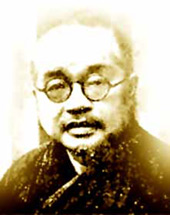Views
From DMCB Wiki
(Difference between revisions)
m |
m |
||
| Line 3: | Line 3: | ||
|names=* Lay name 俗名: Lǔ Pèilín 吕沛林 | |names=* Lay name 俗名: Lǔ Pèilín 吕沛林 | ||
* Dharma name 法名: Wéixīn 唯心 | * Dharma name 法名: Wéixīn 唯心 | ||
| - | * Pen name 筆名: Bēihuá 悲華<ref> | + | * Pen name 筆名: Bēihuá 悲華<ref>Luo Tongbing connects Tàixū to this pen name in a forthcoming volume</ref> |
|image=[[File:Taixu.jpg|center|Tàixū]] | |image=[[File:Taixu.jpg|center|Tàixū]] | ||
| - | |birth=1/8, [[1890]] (Guāngxù 光緒 16) in | + | |birth=1/8, [[1890]] (Guāngxù 光緒 16) in Cháng'ān Town 長安鎮, Hǎiníng county 海寧縣, Zhèjiāng 浙江 |
|death=3/17, [[1947]] (Mínguó 民國 36) at Yùfó Temple 玉佛寺, Shànghǎi 上海 | |death=3/17, [[1947]] (Mínguó 民國 36) at Yùfó Temple 玉佛寺, Shànghǎi 上海 | ||
|associates=Notable Associates: | |associates=Notable Associates: | ||
| - | * | + | * Fǎfǎng 法舫 |
| + | * Dàojiē 道階 | ||
| + | * Yú Déyuán 虞德元 | ||
| + | * Zhāng Huàshēng 張化聲 | ||
| + | * Mǎnzhì 滿智 | ||
| + | * Zhīfēng 芝峰 | ||
| + | * Dàxǐng 大醒 | ||
| + | * Táng Dàyuán 唐大圓 | ||
| + | * Yáng Wénhuì 楊文會 | ||
| + | * Yù Huìguān 玉慧觀 | ||
| + | * Chángxǐng 常惺 | ||
| + | * Dìxián 諦閑 | ||
| + | * Huáng Chànhuá 黃懺華 | ||
| + | * Fàn Gǔnóng 范古農 | ||
| + | * Yuányīng 圓瑛 | ||
| + | * Fúshàn 福善 | ||
| + | * Míngshān 茗山 | ||
| + | * Shànyīn 善因 | ||
| + | * Huìjué 會覺 | ||
| + | * Shǐ Yīrú 史一如 | ||
| + | * Hán Qīngjìng 韓清淨 | ||
| + | * Wáng Yītíng 王一亭 | ||
| + | * Kōngyě 空也 | ||
| + | * Zōngyǎng 宗仰 | ||
| + | * Hú Zǐhù 胡子笏 | ||
| + | * Chén Yuánbái 陳元白 | ||
| + | * Wáng Sēnfǔ 王森甫 | ||
| + | * Táiyuán 台源 | ||
| + | * Rénshān 仁山 | ||
|editor-name=Gregory Adam Scott | |editor-name=Gregory Adam Scott | ||
}} | }} | ||
| Line 14: | Line 42: | ||
== Tàixū 太虛 (1890-1947) == | == Tàixū 太虛 (1890-1947) == | ||
| - | Tàixū was one of the most influential Chinese Buddhist figures of the modern era, a reformer who established seminaries and Buddhist periodicals, such as his long-running Hǎicháo yīn [[海潮音]]. | + | Tàixū was one of the most influential and well-known Chinese Buddhist figures of the modern era, a reformer who established seminaries and Buddhist periodicals, such as his long-running Hǎicháo yīn [[海潮音]]. |
| + | |||
'''Biography''' | '''Biography''' | ||
| Line 20: | Line 49: | ||
---- | ---- | ||
'''Important Works''' | '''Important Works''' | ||
| + | |||
| + | * ''Lectures in Buddhism''. Paris: Les Amis de Bouddhisme, 1928. | ||
| + | * 佛學的將來 (The Future of Buddhism), 1935. | ||
| + | * 法相唯識學 (Dharmalakṣaṇa and Consciousness-Only), 1938. | ||
| + | * 護國言論集 (Collected Speeches on Protecting the Nation), 1939 | ||
| + | * 太虛大師全書 (The Complete Works of Venerable Taixu), 20 Vols., 1956. | ||
| + | * 整頓僧伽制度論 (On Reorganizing the Monastic System), 1958. | ||
---- | ---- | ||
Revision as of 08:38, 16 March 2010
Tàixū 太虛 (1890-1947)
|
Notable Associates:
|
|
Tàixū 太虛 (1890-1947)
Tàixū was one of the most influential and well-known Chinese Buddhist figures of the modern era, a reformer who established seminaries and Buddhist periodicals, such as his long-running Hǎicháo yīn 海潮音.
Biography
Important Works
- Lectures in Buddhism. Paris: Les Amis de Bouddhisme, 1928.
- 佛學的將來 (The Future of Buddhism), 1935.
- 法相唯識學 (Dharmalakṣaṇa and Consciousness-Only), 1938.
- 護國言論集 (Collected Speeches on Protecting the Nation), 1939
- 太虛大師全書 (The Complete Works of Venerable Taixu), 20 Vols., 1956.
- 整頓僧伽制度論 (On Reorganizing the Monastic System), 1958.
Notes
- ↑ Luo Tongbing connects Tàixū to this pen name in a forthcoming volume
References:
- Pittman, Don A. Toward a Modern Chinese Buddhism: Taixu's Reforms. Honolulu: University of Hawai'i Press, 2001.
- Shì Dōngchū 釋東初. Zhōngguó Fójiào jìndài shǐ 中國佛教近代史 (A History of Early Contemporary Chinese Buddhism), in Dōngchū lǎorén quánjí 東初老人全集 (Complete Collection of Old Man Dongchu), vols. 1-2. Taipei: Dongchu, 1974 Pp. 2.805-811.
- Shì Tàixū 釋太虛. Tàixū dàshī quánshū 太虛大師全書, 10 vols. Beijing: Zongjiao wenhua chubanshe, 2005.
- Shì Tàixū 釋太虛, ed. Fǎxiàng wéishì xué 法相唯識學. Beijing: Shangwu yinshuguan, 2002. Originally published in Chángshā 長沙, c. 1938.
- Yú Língbō 于凌波, ed. Xiàndài Fójiào rénwù cídiǎn 現代佛教人物辭典 (A Dictionary of Modern Buddhist Persons), 2 vols. Taipei: Foguang, 2004. Pp. 1.95b-97c.
